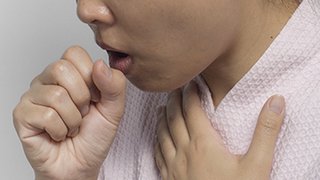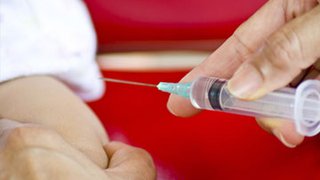Symptoms of Bronchiectasis
Common symptoms include:
- Daily production of large amounts of foul-smelling, yellow or green sputum (spit) that can contain mucus and pus
- Fatigue
- Chronic cough, sometimes with blood
- Low-grade fever or chills
- Shortness of breath that gets worse with exercise
- Wheezing
- Clubbing of fingers (rare)
Diagnosing Bronchiectasis
Our skilled pulmonologists carefully assess each patient, beginning with a thorough evaluation that includes a:
- Discussion of symptoms
- Review of personal and family medical history
- Physical exam
To confirm a diagnosis, we often recommend one or more additional tests, such as:
- Blood tests: Tests of a patient’s blood sample to check for signs of infection or other conditions that might be causing bronchiectasis
- Bronchoscopy: Minimally invasive procedure to view the airways using a thin, flexible tube with a tiny light and camera (bronchoscope) to check for blockages or sources of bleeding
- Chest X-ray: Technology that uses radiation to produce images of the lungs to check for abnormal lung tissue and thickened airways
- Computed tomography (CT) scan: Imaging to see the location and extent of lung damage, using specialized X-ray technology that takes cross-sectional images to produce detailed 3D images
- Pulmonary function tests: Procedures to evaluate lung function, such as the amount and rate of air flow in and out of the lungs and how well the lungs move oxygen into the bloodstream
- Sputum culture: Tests of a patient’s spit sample to check for bacteria, fungus, or other sources of infection
- Sweat test: Test of a patient’s sweat sample for signs of cystic fibrosis
Treatment for Bronchiectasis
Early diagnosis and treatment of underlying causes of bronchiectasis can help prevent further lung damage. Treatment aims to:
- Treat lung infections or other underlying conditions
- Remove excess mucus from the lungs
- Prevent complications such as respiratory and heart failure
Several types of medication can help relieve symptoms. Based on each patient’s individual symptoms and health needs, we prescribe medications such as:
- Antibiotic, antiviral, or antifungal medications to treat lung infections, based on their cause
- Bronchodilators (inhaled medications) to open airways and improve breathing
- Expectorants to help loosen sputum so that patients can cough it up from the lungs
Other nonsurgical treatments include:
- Breathing techniques to help move mucus up from the lungs into the upper airways to make it easier to cough up
- Chest physical therapy, or chest percussion, with a respiratory therapist to help loosen mucus so that patients can cough it up
- Oxygen therapy for people with widespread bronchiectasis to help with breathing
- Pulmonary rehabilitation with respiratory therapists to help patients breathe better and improve their ability to exercise or do other activities
Treatment with surgery might be necessary if other treatments have not helped. Surgical options include:
- Surgery for major bleeding in areas of an airway, either to remove part of the airway or to control the bleeding
- Lung transplant for people with severe bronchiectasis
Preventing Bronchiectasis
Bronchiectasis can be prevented mainly by avoiding lung infections and lung damage that can cause it. Prevention methods include:
- Childhood vaccines to prevent measles and whooping cough
- Prompt, effective treatment of children’s lung infections to preserve lung function and prevent lung damage
- Avoidance of fumes, gases, smoke, and other toxic substances that can damage the lungs
- Preventing children from inhaling food or other objects, or prompt medical care if they do









